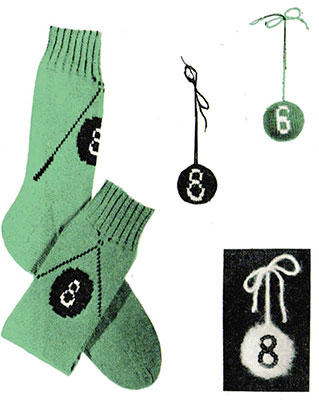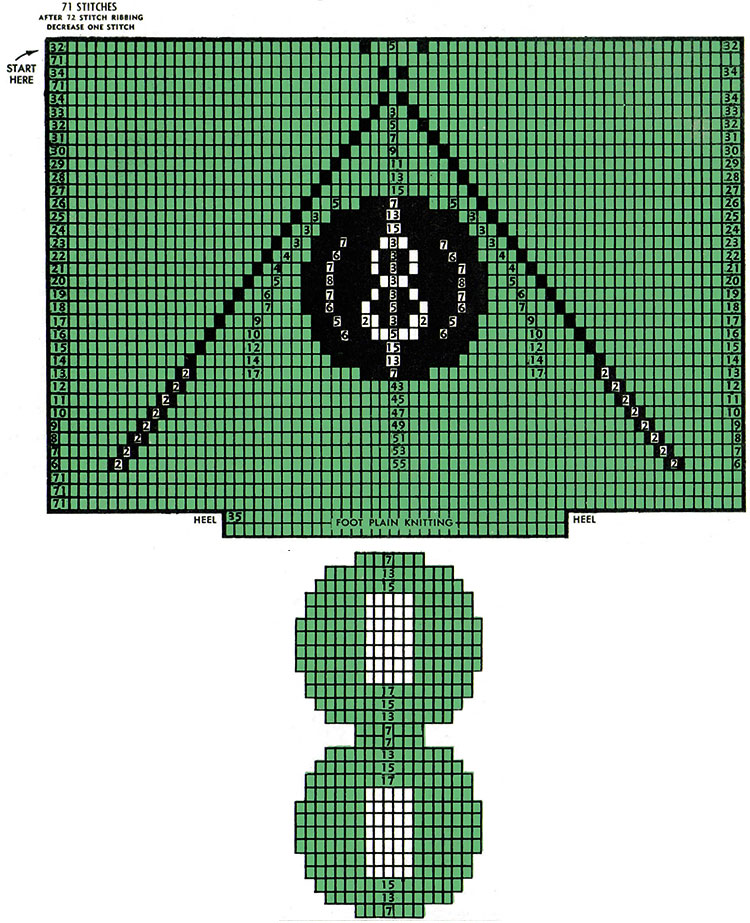Newly Added Knit Patterns
8-Ball Socks Pattern #7285

Simplified multi-color knitting with color charts. Stitch sequences numbered. Each row knitted across and purled back in the same colors. Sock sizes 10 to 13.
IMPORTANT
Knit across and purl back each row before starting next row. Use size NUMBER ONE needles. Knitting tension should be tight enough to produce about 10 stitches per inch. If you do not obtain this gauge, then change to larger or smaller needles as your particular knitting tension requires. The size needle does not matter as long as the stitch gauge attained is correct. Note: 10 stitches per inch means 'as knit', without allowance for blocking. Socks then block to about 9 stitches per inch on usual size dryers, and will cling snugly to the average size leg when worn. For a very small size leg (such as 7 inches around above ankle) you may wish to knit to a tighter tension gauge than mentioned above, using the smallest possible needles. Use your own choice of yarn colors.
8-BALL CAR CHARM
NOTE (SOCK PATTERN): In choosing yarn, be sure colors selected are in good contrast to show the design in sharp detail. Almost any bright color will be a suitable background for the black pool cues and 8-Ball. Avoid very dark shades of blue, green or grey. You might wish to make your 8-Ball in dark brown on a background of beige; or in Navy blue on a background of light blue, or Kelly green, or other bright color. Substitute your own choice of color and number for the pool ball, if you wish.
NOTE: Knit the 8-Ball charm directly from the graph as shown on sock pattern, repeating pattern from base upward for second half. Or, knit your own choice of number using separate graph shown, filling in desired number. Be sure and place base of number upward in lower half (number upside down) so it will be upright when work is folded around ball.
Material required: Approx. 10 yds. background color, 2 yds. for number (3 ply sock yarn). (In Angora 12 yds.)
Knit the pattern as shown, in the usual manner, as a flat piece. Be sure and purl back EACH ROW before starting next row. Size of work will depend entirely upon your stitch gauge. If you wish to have the knitted piece fit neatly around a ping pong ball (1½” diameter), knit 10 stitches per inch, using your #1 sock needles. If it is desired to fit a larger ball, add stitches at ends of each row, or knit with larger needles to obtain a coarser stitch gauge. Upon completion of pattern, block and press your work flat first. Then fold and sew edges together around a ping pong ball (or other ball of correct size), in the same manner you would sew a pattern sock together up the back. Work should stretch slightly over surface of the ball to present a neat appearance. Attach strand of yarn to top of ball for use in hanging up the 8-ball as a car charm.
DIRECTIONS
(Directions herein are complete, including recommended methods for heel and toe. Free detailed instructions for beginners on how to knit, purl, etc., should be obtainable from the shop where yarn is purchased.)
MATERIALS—(Note: Different brands of yarn vary in yardage. The following yarn quantities for an average size pair of socks, are approximate only.) 2½ oz. basic color (green), ⅛ oz. black, 2 yds. white. Socks illustrated are 7 inches long above top of heel, including 2 inches of ribbing. If longer or shorter socks are desired, change length of ribbing, or number of plain rows at the top or below pattern design. Use size Number One sock needles, double pointed, and regular 3-ply sock yarn.
IMPORTANT (Handling Yarn)—Use needles and yarn in the above accurate sizes in order to have sock of proper size per this pattern. Knitting tension should produce 10 stitches per inch. Use BOBBINS to carry your yarn in small quantities of each color. These will dangle clear of your work, avoiding entanglement. For certain small areas of color involving only a few stitches, you may prefer to merely use SHORT STRANDS of yarn, 12 to 15 inches long, dangling free, instead of bothering to wind separate bobbins. RECOMMENDATION—Make free use of additional bobbins or short strands as new color groups are encountered. A given strand will often be used over again for stitches in the same color group in the following rows, so be sure it is started long enough for the color group it is to handle. CAUTION—It is not desirable to carry one color yarn across the wrong side of another color, to reach stitches of the same color farther along the row. This would save extra strands of yarn, but in so doing the tension variation is likely to cause distortion of the stitches and thus spoil the clarity of the design. In some cases this carry-over of yarn can be accomplished satisfactorily across only one or two stitches of another color, where design detail is not too critical. Some experienced knitters can carry yarn across even more than 1 stitches and avoid a loose loop on inside of sock by twisting the yarn carried with the yarn being worked, but the danger of design distortion must be considered. You will have a more beautiful finished article if separate strands are used freely. The only inconvenience is a few more yarn ends to take care of in finishing inside of sock.
RECOMMENDATION ON BOBBINS FOR THIS PATTERN—Knit from one bobbin or ball of basic color for the first 12 rows, carrying yarn across single stitches in the pool cues. Use 2 bobbins (or short strands) of black for the cues. Upon reaching the 8-ball, use separate bobbins of background color for areas on each side of ball, shifting to 3 bobbins below the ball, where the areas are further separated by 2-stitch interruptions of the pool cues. Use 2 bobbins of black for the 8-ball, in working around the white number. Use short strands of white for the number, and for the black areas within the number. Total 7 bobbins required. (3 background color, 4 black) plus short strands.
CHOICE OF NUMBER—If you wish to substitute your own choice of number, fill in the squares with a pencil to form number desired. You may use chart provided for car charm, and follow design of sample numbers as given below. Count and number your stitch groups, or simply count squares while knitting this part.
CAR CHARM—Directions are given on front of pattern for this charm. It may be knitted in regular sock yarn or in Angora. If Angora is used, the 100% French Angora is recommended since it is the fuzziest. Some brands of this yarn are heavy in texture and might make the ball too large to be attractive. If you do not obtain the proper stitch gauge (about 8½ st. per inch in Angora), the lighter Angora may be obtained by untwisting one ply of the yarn, then knitting with the part remaining.
LEG PATTERN—This part of sock is knitted in a flat piece, eventually to be folded and sewed together up the back. The successive rows on the pattern are knitted in order from left to right and each row is purled back. Each pattern row thus represents 2 rows of usual knitting. First cast on 72 stitches of basic color and knit 2, purl 2, for ribbing for 2 inches. Knit the first row of pattern as shown on graph, that is 32 green, 1 black, 5 green, 1 black, 32 green. These numbers are indicated on graph to save counting squares. In changing colors always twist yarns around each other once to avoid leaving a hole. Now turn and purl back ON THIS SAME ROW using the same colors in the same places. Now knit row No. 2 in the indicated color sequence, in this case a plain row of green, and purl back as before. Continue knitting the successive rows in this manner using the color sequences indicated on the graph. After row No. 36 the work separates to knit the heel. Divide the 72 stitches, taking 18 off each end and place on a separate needle for the heel. In so doing the leg of the sock is folded into position for sewing up the back later. Leave the 36 center stitches on one needle and discontinue work thereon while doing the heel.
HEEL—(Reinforced type) Using the 36 heel stitches, slip 1, knit 1 in sequence for the first row, then purl back. Continue thus in successive rows for 2 inches. On the last purl row, purl 20 stitches, then purl 2 together, purl 1 and turn work. Then:
Knit back 6, knit 2 together, knit 1, turn.
Purl back 7, purl 2 together, purl 1, turn.
Knit back 8, knit 2 together, knit 1, turn.
Purl back 9, … etc.
Knit back 10, … etc.
… Etc.
Continue in this manner, advancing the number of stitches worked at each end in this order, and thus making rounded bottom of heel, until all stitches are used, work then being all on one needle across bottom of heel. Now pick up stitches along the forward edges of the heel thus knitted, and add to the work in progress. About 21 or 22 stitches should be picked up on each side of the 2-inch long heel, and all of these heel stitches should be evenly divided on 2 needles.
INSTEP—At this point the entire sock is on three needles, consisting of the instep needle with the 36 center stitches (which must be kept separate), and the two underfoot needles on which the stitches along the edge of the finished heel are evenly divided. Now use a 4th working needle and knit the plain-color foot round and round as with plain socks, and at the same time form the triangular gusset which widens the ankle, by decreasing 1 stitch at the forward point of each underfoot needle ON EVERY OTHER ROW until only 18 stitches remain on each underfoot needle. You will probably decrease 13 or 14 times depending on whether 21 or 22 stitches were picked up along the heel edge. Continue knitting the foot without further decreasing until 2½ inches from the desired length of the foot.
TOE—Now start decreasing to shape toe, as follows: Decrease 4 stitches on the next row, these being the end stitches on the instep needle, and the stitches next to these, one on each under-foot needle. Knit 4 rows plain then 1 row decreasing 4 stitches as before, 3 rows plain, 1 decreasing, 3 plain, 1 dec., 2 plain, 1 dec., 2 plain, 1 dec., 1 plain, 1 dec., then decrease every row until only 16 stitches remain (8 on instep needle and 4 on each underfoot needle.) Weave toe as follows: Place yarn in a tapestry needle and, with yarn coming from back of knitting needle, put it in first stitch of front (instep) needle as if to knit and slip it off. Then put it in the next stitch of front needle as if to purl and leave it on. Go to back (underfoot) needle and insert as if to purl and take it off, then to next stitch of back needle as if to knit and leave it on. This designation may assist:
Front needle K—off P—on
Back needle P—off K—on
Repeat thus to the end of the 8 stitches on each needle.
FINISH—Sew sock up the back, using corresponding color of yarn and tapestry needle. Finish inside of sock by weaving any thread ends into nearby seams, trimming ends, etc. Block socks on dryers of proper size.
GENERAL DIRECTIONS
Each square equals one stitch, knitted and/or purled. Sequences of stitches in particular colors to form a pattern are shown in color and by numbers on the specific pattern graphs. This saves counting squares. The number of row and number of stitches in each, depend on the symmetry of the pattern design, also on the approximate size of sock desired in order to fit the wearer's leg. Size and dimensions are indicated in each particular pattern.
Each row is normally knitted and purled back in the same colors. For certain patterns which are easily repeated, the knitter may, in purling back, go to the next row. In this case the indicated pattern will be reduced in size by one-half, and the entire pattern must then be repeated in order to achieve the length indicated.
Heel, bottom of foot, and toe are knitted in the manner of plain socks. In certain patterns where the instep is a plain color, and the same color as the foot, this part of the sock may be knitted round and round as in plain socks.

| Pattern Categories Browse the categories to help you find the patterns you're looking for. |
||
|
||










